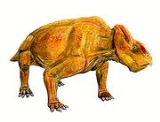
Ischigualastia
Encyclopedia
Ischigualastia was a dicynodont
(a group of mammal-like reptiles) that lived during the Carnian age
of the Late Triassic
Period. From the Ischigualasto Formation
of Argentina
, it was a member of the family Kannemeyeridae.
It is regarded as larger than its later, more famous relative Placerias
, which was up to 3.5 meters long (11.5 ft) and weighed one to two tonnes (1.1 to 2.2 short tons). Unlike Placerias, it lacked tusks. It was a large quadruped
al herbivore
, most common at the base of the Ischigualasto Formation.
Dicynodont
Dicynodontia is a taxon of anomodont therapsids or mammal-like reptiles. Dicynodonts were small to large herbivorous animals with two tusks, hence their name, which means 'two dog tooth'...
(a group of mammal-like reptiles) that lived during the Carnian age
Carnian
The Carnian is the lowermost stage of the Upper Triassic series . It lasted from about 228.7 till 216.5 million years ago . The Carnian is preceded by the Ladinian and is followed by the Norian...
of the Late Triassic
Late Triassic
The Late Triassic is in the geologic timescale the third and final of three epochs of the Triassic period. The corresponding series is known as the Upper Triassic. In the past it was sometimes called the Keuper, after a German lithostratigraphic group that has a roughly corresponding age...
Period. From the Ischigualasto Formation
Ischigualasto
Ischigualasto is a geological formation and a natural park associated with it in the province of San Juan, north-western Argentina, near the border with Chile...
of Argentina
Argentina
Argentina , officially the Argentine Republic , is the second largest country in South America by land area, after Brazil. It is constituted as a federation of 23 provinces and an autonomous city, Buenos Aires...
, it was a member of the family Kannemeyeridae.
It is regarded as larger than its later, more famous relative Placerias
Placerias
Placerias was a dicynodont that lived during the late Carnian age of the Triassic Period...
, which was up to 3.5 meters long (11.5 ft) and weighed one to two tonnes (1.1 to 2.2 short tons). Unlike Placerias, it lacked tusks. It was a large quadruped
Quadruped
Quadrupedalism is a form of land animal locomotion using four limbs or legs. An animal or machine that usually moves in a quadrupedal manner is known as a quadruped, meaning "four feet"...
al herbivore
Herbivore
Herbivores are organisms that are anatomically and physiologically adapted to eat plant-based foods. Herbivory is a form of consumption in which an organism principally eats autotrophs such as plants, algae and photosynthesizing bacteria. More generally, organisms that feed on autotrophs in...
, most common at the base of the Ischigualasto Formation.
External links
- Ischigualastia at Palaeos.com.

